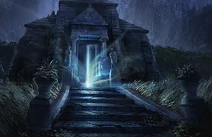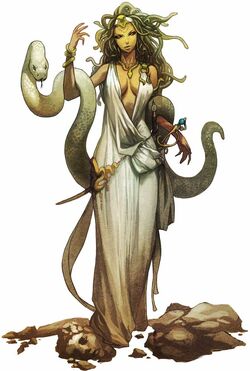No edit summary |
No edit summary |
||
| (16 intermediate revisions by 3 users not shown) | |||
| Line 1: | Line 1: | ||
| − | {{ |
+ | {{Disclaimer}} |
| − | {{ |
+ | {{Species |
| + | |Alternate Names/Spellings= |
||
| + | |Origins= Greek Mythology |
||
|Alignment = Neutral Evil, Chaotic Neutral, Chaotic Evil |
|Alignment = Neutral Evil, Chaotic Neutral, Chaotic Evil |
||
| − | |Element = Earth, Poison/Acid/Plague, |
+ | |Element = Darkness/Shadow, Earth, Life/Death/Blood, Poison/Acid/Plague, Water |
|Species = Monstrous Humanoid |
|Species = Monstrous Humanoid |
||
|Appearance = Frightening Serpentine Humanoid |
|Appearance = Frightening Serpentine Humanoid |
||
| Line 9: | Line 11: | ||
| + | |||
| + | ==Also Called== |
||
| + | |||
| + | *Gorgo (Gorgô) |
||
| + | |||
| + | *(pl) Gorgones |
||
==Origins== |
==Origins== |
||
| − | The [http://warriorsofmyth.wikia.com/wiki/Gorgon_Gallery Gorgon] is a |
+ | The [http://warriorsofmyth.wikia.com/wiki/Gorgon_Gallery Gorgon] is one of a race of creatures with origins in Greek mythology, legend and folklore. The term 'Gorgon' itself is derived from the Greek 'gorgo', meaning 'grim', 'fierce' or 'terrible'. |
The first and undoubtedly most famous [http://www.theoi.com/Pontios/Gorgones.html Gorgons (Gorgones)] were a trio of sisters, named Euryale ("of the wide, briny sea" or the "wide-stepping"; the eldest sister), Stheno (Sthenno, Sthenusa, the "strong one" or the "mighty one"; the middle sister) and Medusa (Medousa, the "queen" or "guardian"; the youngest sister, and the only mortal sister of the three). Though, the myths vary when it comes to the nature of the Gorgon sisters' origins. |
The first and undoubtedly most famous [http://www.theoi.com/Pontios/Gorgones.html Gorgons (Gorgones)] were a trio of sisters, named Euryale ("of the wide, briny sea" or the "wide-stepping"; the eldest sister), Stheno (Sthenno, Sthenusa, the "strong one" or the "mighty one"; the middle sister) and Medusa (Medousa, the "queen" or "guardian"; the youngest sister, and the only mortal sister of the three). Though, the myths vary when it comes to the nature of the Gorgon sisters' origins. |
||
| − | In one account, they are the daughters of sea-god [http://www.theoi.com/Pontios/Phorkys.html Phorcys (Phorkys)] and sea-goddess [http://www.theoi.com/Pontios/Keto.html Ceto (Keto)]; that made them |
+ | In one account, they are the daughters of sea-god [http://www.theoi.com/Pontios/Phorkys.html Phorcys (Phorkys)] and sea-goddess [http://www.theoi.com/Pontios/Keto.html Ceto (Keto)]; that made them sisters of [http://www.theoi.com/Pontios/Graiai.html The Graiae (Gray Women)], the monster [http://www.theoi.com/Ther/DrakainaEkhidna1.html Echidna] (Ekhidna, the wife of [http://www.theoi.com/Gigante/Typhoeus.html Typhon] and mother of numerous other famous monsters) and [http://www.theoi.com/Ther/DrakonHesperios.html Ladon] (the dragon who guarded the Tree of the Apples of the [http://www.theoi.com/Titan/Hesperides.html Hesperides]). According to this, they are monstrous from birth, and no reason is given as to why Medusa is the only mortal Gorgon. |
| ⚫ | In another account, they are sister priestesses (still born of Phorcys and Ceto) who served in a temple of Athena. According to this, the three were turned into hideous monsters as punishment for Medusa's sexual affair with the sea-god [http://www.theoi.com/Olympios/Poseidon.html Poseidon], in a flowery meadow or in Athena's temple (a double offense; not only did the three sisters vow to remain chaste, but Athena and Poseidon were bitter rivals; a triple offense, if their sexual affair took place in Athena's temple, as many believe it did). |
||
[[File:Medusa and Statues.jpg|thumb|left|212px|Her lair is a sanctuary of stone and untimely death...]] |
[[File:Medusa and Statues.jpg|thumb|left|212px|Her lair is a sanctuary of stone and untimely death...]] |
||
| ⚫ | |||
| ⚫ | In another account, they are sister priestesses (still born of Phorcys and Ceto) who served in a temple of Athena. According to this, the three were turned into hideous monsters as punishment for Medusa's sexual affair with the sea-god [http://www.theoi.com/Olympios/Poseidon.html Poseidon], in a flowery meadow or in Athena's temple (a double offense; not only did the three sisters vow to remain chaste, but Athena and Poseidon were bitter rivals; a triple offense if their sexual affair took place in Athena's temple). |
||
| − | |||
| ⚫ | |||
And after Medusa is slain by Perseus, the Gorgon's head is mounted on Athena's Aegis Shield, as not only a weapon, but a terrifying reminder of the goddess's wrath against rivals, enemies and traitors. |
And after Medusa is slain by Perseus, the Gorgon's head is mounted on Athena's Aegis Shield, as not only a weapon, but a terrifying reminder of the goddess's wrath against rivals, enemies and traitors. |
||
| − | In yet another account, the Gorgons are said to be born monsters, but rather than daughters of Ceto and ''Phorcys'', are said to be daughters of Ceto and |
+ | In yet another account, the Gorgons are said to be ''born'' monsters, but rather than daughters of Ceto and ''Phorcys'', are said to be daughters of Ceto and a monstrous underworld male phantom named [http://www.theoi.com/Titan/GorgoAix.html ''Gorgon'' (Gorgo, Aex, Aix)]. Some make this monster a son of the sun-god, [http://www.theoi.com/Titan/Helios.html Helios]. |
| − | Though, |
+ | Though, still more accounts make the singular male Gorgon a son of Phorcys and Ceto, and the father of the Gorgon sisters by an ''unknown'' mother, thus making both Phorcys ''and'' Ceto their grandparents. And others besides those make the male Gorgon a son of Typhon and Echidna, and thus ''himself'' a grandchild of Phorcys and Ceto, and accordingly, a ''nephew'' of those same Gorgon sisters. |
| − | Some even claim this Gorgon is female, and thus a ''daughter'' of Typhon and Echidna. In such accounts, she is also a nurse of [http://www.theoi.com/Olympios/Zeus.html Zeus], the King of the Gods, when he was a baby; though, in adulthood, Zeus would go on to slay and decapitate her, at the beginning of the [http://en.wikipedia.org/wiki/Titanomachy Titan War (Titanomachy)]. Her flayed skin would be used to make Zeus' Aegis Cloak (rather than the skin of his [[nymph]] nurse [http://www.theoi.com/Ther/AixAmaltheia.html Amaltheia] or the [[Titan]] [http://www.theoi.com/Titan/TitanPallas.html Pallas]); her severed head would be brandished on Athena's Aegis Shield (rather than the head of Medusa). |
+ | Some even claim this singular Gorgon is female, and thus a ''daughter'' of Typhon and Echidna. In such accounts, she is also a nurse of [http://www.theoi.com/Olympios/Zeus.html Zeus], the King of the Gods, when he was a baby; though, in adulthood, Zeus would go on to slay and decapitate her, at the beginning of the [http://en.wikipedia.org/wiki/Titanomachy Titan War (Titanomachy)]. Her flayed skin would be used to make Zeus' Aegis Cloak (rather than the skin of his [[nymph]] nurse [http://www.theoi.com/Ther/AixAmaltheia.html Amaltheia] or the [[Titan]] [http://www.theoi.com/Titan/TitanPallas.html Pallas]); her severed head would be brandished on Athena's Aegis Shield (rather than the head of Medusa). |
[[File:Preview001 (edited).JPG|thumb|right|212px|"You won't leave alive..."]] |
[[File:Preview001 (edited).JPG|thumb|right|212px|"You won't leave alive..."]] |
||
| − | Likewise, some accounts document the Gorgons' home as an island in the West. These accounts place them in the same neighborhood as The Graiae (their sisters, who guard them), the Hesperides (who live on a shining beautiful island beyond the Graiae) and numerous other deities. Though, in other later accounts, it is documented that the home of the Gorgons lies somewhere in Libya. |
+ | Likewise, some accounts document the Gorgons Sisters' home as an island in the West. These accounts place them in the same neighborhood as The Graiae (their sisters, who guard them), the Hesperides (who live on a shining beautiful island beyond the Graiae) and numerous other deities. Though, in other later accounts, it is documented that the home of the Gorgons lies somewhere in Libya. |
Though, some parts of the myth remain intact, regardless of who tells the tale. The hero [http://www.theoi.com/Heros/Perseus.html Perseus] is sent to slay Medusa by King Polydektes of Seriphos. To help with his journey, Hermes equipped Perseus with Hades' Helmet of Invisibility, Hermes' winged sandals, Athena's adamantine sickle and a reflective shield. |
Though, some parts of the myth remain intact, regardless of who tells the tale. The hero [http://www.theoi.com/Heros/Perseus.html Perseus] is sent to slay Medusa by King Polydektes of Seriphos. To help with his journey, Hermes equipped Perseus with Hades' Helmet of Invisibility, Hermes' winged sandals, Athena's adamantine sickle and a reflective shield. |
||
| Line 40: | Line 47: | ||
When he finds the Gorgons, some accounts say that Perseus sneaks up on them, while others say that he actually does battle with them. Either way, Perseus defeats Medusa by beheading her. |
When he finds the Gorgons, some accounts say that Perseus sneaks up on them, while others say that he actually does battle with them. Either way, Perseus defeats Medusa by beheading her. |
||
| − | And soon after (how long after is hard to say), from the bloody neck-stump of Medusa's decapitated body, emerges the [[Pegasus|winged horse]] [http://www.theoi.com/Ther/HipposPegasos.html Pegasus] (who would later go on to help the hero [http://www.theoi.com/Heros/Bellerophontes.html Bellerophon] defeat the [[Chimera]]) and Pegasus' brother, the winged boar |
+ | And soon after (how long after is hard to say), from the bloody neck-stump of Medusa's decapitated body, emerges the [[Pegasus|winged horse]] [http://www.theoi.com/Ther/HipposPegasos.html Pegasus] (who would later go on to help the hero [http://www.theoi.com/Heros/Bellerophontes.html Bellerophon] defeat the [[Chimera]]) and Pegasus' brother, the [[Flying Pig|winged boar]]—or [[giant]]-- [http://www.theoi.com/Ther/Khrysaor.html Chrysaor] (who would later go on to father the three-bodied [[giant]] [http://www.theoi.com/Gigante/GiganteGeryon.html Geryon]). |
Though, after Perseus' defeat of Medusa, it is unknown what happens to her sisters. It is likewise unknown if all subsequent Gorgons descend from Euryale, Stheno, Medusa, or their relative, the monster Gorgon (who may or may not have been the only ''male'' Gorgon). As such, it is commonly speculated that ''each'' left behind their own family tree of Gorgon descendants. |
Though, after Perseus' defeat of Medusa, it is unknown what happens to her sisters. It is likewise unknown if all subsequent Gorgons descend from Euryale, Stheno, Medusa, or their relative, the monster Gorgon (who may or may not have been the only ''male'' Gorgon). As such, it is commonly speculated that ''each'' left behind their own family tree of Gorgon descendants. |
||
| Line 57: | Line 64: | ||
However the case may be, since the days of Medusa, Gorgons have come to greatly vary in their appearances. Skin color and pattern may vary as vastly as a reptile's coloration, and eye color may be nearly any color (normal like humanoids, or slit like snakes and other reptiles). |
However the case may be, since the days of Medusa, Gorgons have come to greatly vary in their appearances. Skin color and pattern may vary as vastly as a reptile's coloration, and eye color may be nearly any color (normal like humanoids, or slit like snakes and other reptiles). |
||
| − | Likewise, some Gorgons may have the lower half of a large snake, while others are bipedal (walking upright on two feet), and some have both feet ''and'' tails. Forking of the tongue and the presence or absence of |
+ | Likewise, some Gorgons may have the lower half of a large snake, while others are bipedal (walking upright on two feet), and some have both feet ''and'' tails. Forking of the tongue and the presence or absence of snake-like fangs also vary. |
In the same way, some may have beautiful or handsome features (facial and otherwise), while others look monstrous, even perhaps demonic. And the snakes growing from their heads may replace normal hair, or they may grow in right along with it. |
In the same way, some may have beautiful or handsome features (facial and otherwise), while others look monstrous, even perhaps demonic. And the snakes growing from their heads may replace normal hair, or they may grow in right along with it. |
||
==Behavior== |
==Behavior== |
||
| − | [[File:Greg Horn Medusa-1-.jpg|thumb|right| |
+ | [[File:Greg Horn Medusa-1-.jpg|thumb|right|212px|"Patience, babies...food will be here soon..."]] |
The first Gorgons were born of sea-gods. And yet, some accounts say that they were born monsters, while others say that they were born serpentine, and still others say they were born beautiful, similar to nymphs. As such, accounts of the Gorgons' behavior is also highly variable. |
The first Gorgons were born of sea-gods. And yet, some accounts say that they were born monsters, while others say that they were born serpentine, and still others say they were born beautiful, similar to nymphs. As such, accounts of the Gorgons' behavior is also highly variable. |
||
| − | The accounts that say they were born monstrous, would imply that they were vicious, ravenous and savage. Accounts that say they were born serpentine, would imply that they were devious, cunning and cold-blooded. And accounts that say they were born beautiful |
+ | The accounts that say they were born monstrous, would imply that they were vicious, ravenous and savage. Accounts that say they were born serpentine, would imply that they were devious, cunning and cold-blooded. And accounts that say they were born beautiful (transformed into monsters) would likely make them sensual and manipulative, like a sultry femme fatale. |
| − | Likewise, a Gorgon is known for being just as fierce and serpentine as their ancestors, with only a slightly fairer temperament as children. They are cunning, devious |
+ | Likewise, a Gorgon is known for being just as fierce and serpentine as their ancestors, with only a slightly fairer temperament as children. They are cunning, can be devious and conniving, and they are hardly trustful of others, even of their same species (making only a small exception for members of their family). |
| ⚫ | |||
| ⚫ | |||
| ⚫ | |||
| ⚫ | |||
Though, since the Gorgons were still part human, their descendants still require mother's milk, which is the only thing keeping them from starting life totally independent of their mother. |
Though, since the Gorgons were still part human, their descendants still require mother's milk, which is the only thing keeping them from starting life totally independent of their mother. |
||
| − | Furthermore, Gorgons tend to have a great affinity for snakes and other reptiles, as well as [[Pegasus|Pegasi]] (who paradoxically descend from the same roots). They also prefer to live in places made of (or filled with) stone, such as caves and buildings within the ruins of fallen, old cities. They may or may not enjoy similar diet to that of a snake (rats, lizards, etc). And they are known to greatly enjoy warm weather. |
+ | Furthermore, Gorgons tend to have a great affinity for snakes and other reptiles, as well as [[Pegasus|Pegasi]] (who paradoxically descend from the same roots). They also prefer to live in places made of (or filled with) stone, such as caves and buildings within the ruins of fallen, old cities. They may or may not enjoy similar diet to that of a snake (rats, lizards, etc.). And they are known to greatly enjoy warm weather. |
In fact, Gorgons often tend to despise the cold; some hate the cold because they are cold-blooded, and tend to become sluggish in colder weather. But others are warm-blooded (except for their snake hair), and they still recoil miserably from colder temperatures and weather. |
In fact, Gorgons often tend to despise the cold; some hate the cold because they are cold-blooded, and tend to become sluggish in colder weather. But others are warm-blooded (except for their snake hair), and they still recoil miserably from colder temperatures and weather. |
||
| Line 78: | Line 85: | ||
Gorgons with forked tongues will often stress the S's in their words, making a trademark hissing sound in their voices, while others have raspy or hoarse voices. Common languages among Gorgons are English, Greek (from their origins among the Greek pantheon) and Arabic (from their ancestors' home in Libya). |
Gorgons with forked tongues will often stress the S's in their words, making a trademark hissing sound in their voices, while others have raspy or hoarse voices. Common languages among Gorgons are English, Greek (from their origins among the Greek pantheon) and Arabic (from their ancestors' home in Libya). |
||
==Abilities== |
==Abilities== |
||
| − | [[File:Gorgon-monster-1-.jpg|thumb|right| |
+ | [[File:Gorgon-monster-1-.jpg|thumb|right|272px|"I was beautiful once..."]] |
| − | Gorgons are physically tougher and more powerful than normal humans. In some cases, this may include enhanced flexor muscles, allowing a vice-like squeezing capability (similar to the anaconda, boa constrictor and several other species of constrictor snake). |
||
| − | They may also possess sharp claws, sharp fangs (snake-like or vampiric), perhaps unhinging jaws and/or powerful tails, useful for grabbing or striking. Their skin is often also covered in tough scales, providing even further protection from physical harm. |
||
| − | What's more, a Gorgon's actual physical toughness is sometimes further assisted by rapid regeneration (a superhuman healing factor, similar to when a lizard loses its tail). And as they grow, Gorgons often shed skin like reptiles (which helps with scars and flesh wounds that they get in their lifetime). |
||
| ⚫ | |||
| − | In addition, a Gorgon's fangs are often capable of producing venom, to which they and precious few other species (mainly reptilians) are immune. Though, Gorgon venom varies in its intensity, its incubation time and its biological and psychological effect. |
||
| + | *[https://superpower-list.fandom.com/wiki/Natural_Weapons Natural Weapons]- |
||
| − | And a Gorgon's blood is highly potent. By what seems like a contradictory anatomical mechanism, blood from the ''left'' side of a Gorgon's veins can act as a deadly poison, instantly fatal to most humanoid races; but blood from the ''right'' side of a Gorgon's veins have such powerful healing properties that they can bring the dead back to life. [http://www.theoi.com/Ouranios/Asklepios.html Asclepius] (a son of the Greek sun-god [http://www.theoi.com/Olympios/Apollon.html Apollo]) took advantage of the properties to become a master doctor in his mortal life. |
||
| + | **[https://superpower-list.fandom.com/wiki/Natural_Claws Natural Claws]- |
||
| + | **[https://superpower-list.fandom.com/wiki/Natural_Fangs Natural Fangs]- |
||
| + | |||
| + | *[https://superpower-list.fandom.com/wiki/Ophidian_Hair Ophidian Hair]- |
||
| + | |||
| + | *[https://superpower-list.fandom.com/wiki/Petrifying_Gaze Petrifying Gaze]- |
||
| + | |||
| + | *[https://superpower-list.fandom.com/wiki/Prehensile_Tail Prehensile Tail]- |
||
| + | |||
| + | *[https://superpower-list.fandom.com/wiki/Rapid_Regeneration Rapid Regeneration]- |
||
| + | |||
| + | *[https://superpower-list.fandom.com/wiki/Reptilian_Communication Reptilian Communication]- |
||
| + | |||
| + | *[https://superpower-list.fandom.com/wiki/Scaly_Skin Scaly Skin]- |
||
| + | |||
| + | *[https://superpower-list.fandom.com/wiki/Superhuman_Blood Superhuman Blood]- |
||
| + | **[https://superpower-list.fandom.com/wiki/Resurrection Dextral Sanguinary Resurrection]- |
||
| + | **[https://superpower-list.fandom.com/wiki/Death_Inducing Sinistral Sanguinary Death Inducing]- |
||
| + | |||
| + | *[https://superpower-list.fandom.com/wiki/Superhuman_Strength Superhuman Strength]- |
||
| + | **[https://superpower-list.fandom.com/wiki/Hyperconstriction Hyperconstriction]- |
||
| + | |||
| + | *[https://superpower-list.fandom.com/wiki/Venom_Generation Venom Generation]- |
||
| + | **[https://superpower-list.fandom.com/wiki/Asepsis Venom Immunity]- |
||
| + | |||
| ⚫ | |||
| − | Gorgons may also possess a telepathic and/or empathic rapport with those snakes; some have even been known to be capable of communicating with and/or commanding all snakes (even all reptiles). Less commonly, the ability also extends to other reptilian humanoids. |
||
[[File:Gorgon-lg-1-1-.png|thumb|right|212px|"I dunno...what do ''you'' think?"]] |
[[File:Gorgon-lg-1-1-.png|thumb|right|212px|"I dunno...what do ''you'' think?"]] |
||
| − | And speaking on the note of connections, every Gorgon automatically possesses a symbiotic relationship with a head full of snakes (called Gorgon Snakes). They share with these snakes a powerful metabolism, and when they eat, they share nutrients. Not to mention, warm-blooded Gorgons also automatically share their internal body warmth and their powerful metabolism with these snakes. |
||
| − | Likewise, these 'Gorgon Snakes' tend to be very intelligent (due to their psychic connection to the parent Gorgon, which allows them to share thoughts, feelings and memories). And if removed, a Gorgon Snake can often regenerate into a full snake, independent of their parent. If liberated, these snakes often maintain many, if not all, of their parent Gorgon's physical and psychic capabilities. |
||
| + | ==Weaknesses== |
||
| − | And yet, the Gorgons' most famous ability is that of Petrifaction; the superhuman ability to turn to stone (petrify) any foe with whom they lock glances. With this frightening capability, the Gorgons terrorized the Greeks without mercy, even whilst Medusa was pregnant with Poseidon's children. |
||
| + | |||
| + | *Mirrors |
||
[[Category:Mythical Being]] |
[[Category:Mythical Being]] |
||
| + | [[Category:European Mythology, Legend and Folklore]] |
||
| + | [[Category:Greek Mythology, Legend and Folklore]] |
||
[[Category:Humanoid]] |
[[Category:Humanoid]] |
||
[[Category:Monstrous Humanoid]] |
[[Category:Monstrous Humanoid]] |
||
[[Category:Chimera]] |
[[Category:Chimera]] |
||
| + | [[Category:Reptile]] |
||
| + | [[Category:Swine/Porcine]] |
||
| + | [[Category:Darkness/Shadow/Corruption]] |
||
[[Category:Earth]] |
[[Category:Earth]] |
||
| + | [[Category:Life/Death/Blood]] |
||
[[Category:Poison/Acid/Plague]] |
[[Category:Poison/Acid/Plague]] |
||
| + | [[Category:Water]] |
||
| + | [[Category:G]] |
||
Revision as of 02:39, 10 April 2020
Also Called
- Gorgo (Gorgô)
- (pl) Gorgones
Origins
The Gorgon is one of a race of creatures with origins in Greek mythology, legend and folklore. The term 'Gorgon' itself is derived from the Greek 'gorgo', meaning 'grim', 'fierce' or 'terrible'.
The first and undoubtedly most famous Gorgons (Gorgones) were a trio of sisters, named Euryale ("of the wide, briny sea" or the "wide-stepping"; the eldest sister), Stheno (Sthenno, Sthenusa, the "strong one" or the "mighty one"; the middle sister) and Medusa (Medousa, the "queen" or "guardian"; the youngest sister, and the only mortal sister of the three). Though, the myths vary when it comes to the nature of the Gorgon sisters' origins.
In one account, they are the daughters of sea-god Phorcys (Phorkys) and sea-goddess Ceto (Keto); that made them sisters of The Graiae (Gray Women), the monster Echidna (Ekhidna, the wife of Typhon and mother of numerous other famous monsters) and Ladon (the dragon who guarded the Tree of the Apples of the Hesperides). According to this, they are monstrous from birth, and no reason is given as to why Medusa is the only mortal Gorgon.
In another account, they are sister priestesses (still born of Phorcys and Ceto) who served in a temple of Athena. According to this, the three were turned into hideous monsters as punishment for Medusa's sexual affair with the sea-god Poseidon, in a flowery meadow or in Athena's temple (a double offense; not only did the three sisters vow to remain chaste, but Athena and Poseidon were bitter rivals; a triple offense, if their sexual affair took place in Athena's temple, as many believe it did).
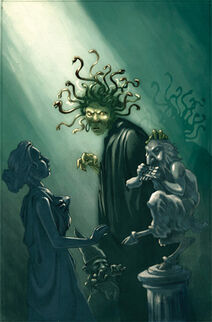
Her lair is a sanctuary of stone and untimely death...
To mark the grievousness of the crime, when the three were transformed, Medusa was the only one to remain mortal (or to lose her immortality; as daughters of Phorcys and Ceto, it is likely that the three were a trio of nymphs, or at least demigoddesses).
And after Medusa is slain by Perseus, the Gorgon's head is mounted on Athena's Aegis Shield, as not only a weapon, but a terrifying reminder of the goddess's wrath against rivals, enemies and traitors.
In yet another account, the Gorgons are said to be born monsters, but rather than daughters of Ceto and Phorcys, are said to be daughters of Ceto and a monstrous underworld male phantom named Gorgon (Gorgo, Aex, Aix). Some make this monster a son of the sun-god, Helios.
Though, still more accounts make the singular male Gorgon a son of Phorcys and Ceto, and the father of the Gorgon sisters by an unknown mother, thus making both Phorcys and Ceto their grandparents. And others besides those make the male Gorgon a son of Typhon and Echidna, and thus himself a grandchild of Phorcys and Ceto, and accordingly, a nephew of those same Gorgon sisters.
Some even claim this singular Gorgon is female, and thus a daughter of Typhon and Echidna. In such accounts, she is also a nurse of Zeus, the King of the Gods, when he was a baby; though, in adulthood, Zeus would go on to slay and decapitate her, at the beginning of the Titan War (Titanomachy). Her flayed skin would be used to make Zeus' Aegis Cloak (rather than the skin of his nymph nurse Amaltheia or the Titan Pallas); her severed head would be brandished on Athena's Aegis Shield (rather than the head of Medusa).
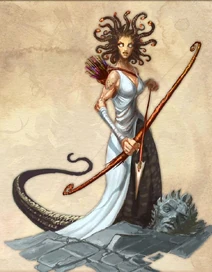
"You won't leave alive..."
Likewise, some accounts document the Gorgons Sisters' home as an island in the West. These accounts place them in the same neighborhood as The Graiae (their sisters, who guard them), the Hesperides (who live on a shining beautiful island beyond the Graiae) and numerous other deities. Though, in other later accounts, it is documented that the home of the Gorgons lies somewhere in Libya.
Though, some parts of the myth remain intact, regardless of who tells the tale. The hero Perseus is sent to slay Medusa by King Polydektes of Seriphos. To help with his journey, Hermes equipped Perseus with Hades' Helmet of Invisibility, Hermes' winged sandals, Athena's adamantine sickle and a reflective shield.
And on his journey, Perseus encounters the Gorgons' sisters, the Graiae; in order to find the location of the Gorgons, he takes the eye that the Graiae share. Again, some say that he threatens to keep the eye for himself, while others say that he threatens to destroy it, or to throw it where they would never be able to find it.
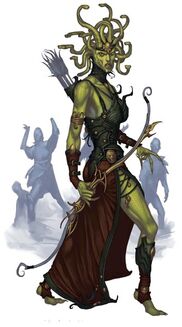
She looks mad...
The Graiae relent, for fear of being without their eye, and give Perseus the information he desires. They gave him directions to find the Gorgons' island home and/or directions where he can get a knapsack, from the nymphs, to keep Medusa's severed head in.
When he finds the Gorgons, some accounts say that Perseus sneaks up on them, while others say that he actually does battle with them. Either way, Perseus defeats Medusa by beheading her.
And soon after (how long after is hard to say), from the bloody neck-stump of Medusa's decapitated body, emerges the winged horse Pegasus (who would later go on to help the hero Bellerophon defeat the Chimera) and Pegasus' brother, the winged boar—or giant-- Chrysaor (who would later go on to father the three-bodied giant Geryon).
Though, after Perseus' defeat of Medusa, it is unknown what happens to her sisters. It is likewise unknown if all subsequent Gorgons descend from Euryale, Stheno, Medusa, or their relative, the monster Gorgon (who may or may not have been the only male Gorgon). As such, it is commonly speculated that each left behind their own family tree of Gorgon descendants.
Appearance
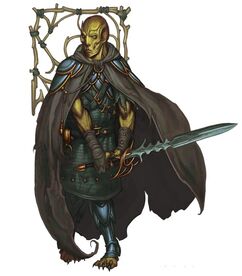
"I WILL find you, and I WILL kill you..."
As daughters of sea-gods, many speculate that the original Gorgons (and perhaps their lesser-known relative Gorgon) were very handsome to look upon, similar to their cousins, the nymphs or demigods. But since their monstrous transformation, the speculation gets somewhat less definite.
Many think that they became hideous, broad-headed monsters with wild eyes, lolling tongues, wide mouths with enormous, gnashing teeth (or swine-like tusks), golden wings, clawed bronze hands, and perhaps even beards (man-like or goat-like is unclear).
These same speculations also claim that the Gorgons secured their clothes with snakes, in the place of normal belts.
Though, others speculated that the Gorgons mostly maintained their physical beauty, with the exception that snakes now replaced (or grew within) their hair. Likewise, their relative Gorgon's true appearance is unknown.
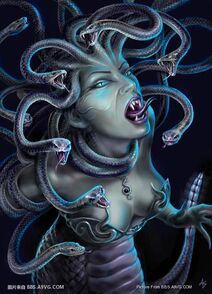
"My EYES are UP HERE..."
Perhaps he (or she) resembled the Gorgon sisters in their transformed serpentine state; perhaps he (or she) resembled a sea-god or an underworld monster. Perhaps he (or she) resembled some monstrous or serpentine or divinely-handsome combination of the former.
However the case may be, since the days of Medusa, Gorgons have come to greatly vary in their appearances. Skin color and pattern may vary as vastly as a reptile's coloration, and eye color may be nearly any color (normal like humanoids, or slit like snakes and other reptiles).
Likewise, some Gorgons may have the lower half of a large snake, while others are bipedal (walking upright on two feet), and some have both feet and tails. Forking of the tongue and the presence or absence of snake-like fangs also vary.
In the same way, some may have beautiful or handsome features (facial and otherwise), while others look monstrous, even perhaps demonic. And the snakes growing from their heads may replace normal hair, or they may grow in right along with it.
Behavior
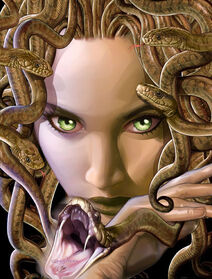
"Patience, babies...food will be here soon..."
The first Gorgons were born of sea-gods. And yet, some accounts say that they were born monsters, while others say that they were born serpentine, and still others say they were born beautiful, similar to nymphs. As such, accounts of the Gorgons' behavior is also highly variable.
The accounts that say they were born monstrous, would imply that they were vicious, ravenous and savage. Accounts that say they were born serpentine, would imply that they were devious, cunning and cold-blooded. And accounts that say they were born beautiful (transformed into monsters) would likely make them sensual and manipulative, like a sultry femme fatale.
Likewise, a Gorgon is known for being just as fierce and serpentine as their ancestors, with only a slightly fairer temperament as children. They are cunning, can be devious and conniving, and they are hardly trustful of others, even of their same species (making only a small exception for members of their family).
Some may behave in a civil manner, but this is a precious rarity, due to their ancestry, which makes for an innately cold, reptilian perspective on socialization. They often reach mental maturity before other children, and are very independent even from a young age.
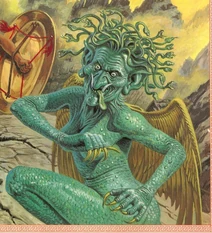
"I'm not afraid of you!"
Though, since the Gorgons were still part human, their descendants still require mother's milk, which is the only thing keeping them from starting life totally independent of their mother.
Furthermore, Gorgons tend to have a great affinity for snakes and other reptiles, as well as Pegasi (who paradoxically descend from the same roots). They also prefer to live in places made of (or filled with) stone, such as caves and buildings within the ruins of fallen, old cities. They may or may not enjoy similar diet to that of a snake (rats, lizards, etc.). And they are known to greatly enjoy warm weather.
In fact, Gorgons often tend to despise the cold; some hate the cold because they are cold-blooded, and tend to become sluggish in colder weather. But others are warm-blooded (except for their snake hair), and they still recoil miserably from colder temperatures and weather.
Gorgons with forked tongues will often stress the S's in their words, making a trademark hissing sound in their voices, while others have raspy or hoarse voices. Common languages among Gorgons are English, Greek (from their origins among the Greek pantheon) and Arabic (from their ancestors' home in Libya).
Abilities
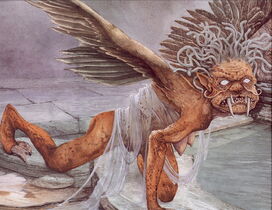
"I was beautiful once..."

"You'd better not peek..."
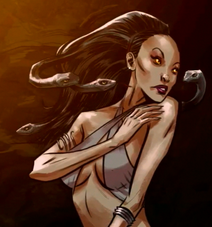
"I dunno...what do you think?"
Weaknesses
- Mirrors
